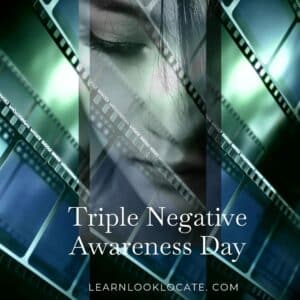
What is Triple Negative Breast Cancer?
As we observe Triple-Negative Breast Cancer Awareness Month this March, it’s a poignant reminder of the collective effort needed to shed light on one of the most challenging forms of breast cancer. Through this blog, Learn Look Locate, aims to demystify TNBC, shed light on its complexities, and offer insights into the current state of care and understanding of this challenging diagnosis.
The Basics of Triple-Negative Breast Cancer
Triple-negative breast cancer is often diagnosed in women under 40, and it’s more prevalent among Black women and those with a BRCA1 mutation. It’s known for its aggressive nature, faster growth, and spread compared to other types of breast cancer, making it a term that often comes with a daunting prognosis. However, it’s essential to recognize that TNBC is not a uniform disease; it encompasses a range of cancers with varying behaviors and responses to treatment.
Signs and Symptoms
The signs and symptoms of TNBC do not differ significantly from other breast cancers. It’s the internal makeup of the cancer cells—lacking ER, PR, and HER2—that sets TNBC apart and guides the treatment approach.
Diagnosis and Prognosis
Diagnosis of TNBC is confirmed when a biopsy reveals cancer cells that test negative for ER, PR, and HER2 proteins. The prognosis for TNBC can be concerning since these cancers tend to grow quickly and are more likely to have spread by the time of diagnosis. Despite this, every individual’s journey with TNBC is unique, and survival rates are continually improving with advancements in treatment and care.
Understanding TNBC Survival Rates
Survival rates for TNBC vary based on the cancer’s stage at diagnosis and other individual factors. While it’s true that the overall survival rates for TNBC are generally lower, there’s a spectrum of outcomes:
- Localized TNBC has a 91% five-year relative survival rate.
- Regional TNBC sees a dip to 66%.
- Distant, or metastatic TNBC, has a five-year relative survival rate of 12%.
It’s crucial to understand these statistics reflect past outcomes and may not fully represent the prognosis for those currently being diagnosed, thanks to advancements in medical treatments.
Treating Triple-Negative Breast Cancer
The absence of ER, PR, and HER2 means that hormone therapies and drugs targeting HER2 are not effective against TNBC. Chemotherapy remains the cornerstone of treatment, sometimes in conjunction with surgery and radiation. Newer treatments, including immunotherapies and PARP inhibitors, are also showing promise, particularly in the advanced stages of the disease.
Debunking Myths Around TNBC
Myth 1: TNBC can be treated the same as other breast cancers.
Reality: TNBC requires a different treatment approach due to the lack of hormone receptors and HER2 protein.
Myth 2: Only African-American women get TNBC.
Reality: TNBC can affect anyone, although it is more prevalent among African-American women.
Myth 3: TNBC is always hard to treat.
Reality: While TNBC can be aggressive, treatment success varies and can be highly effective, especially when the cancer is detected early and hasn’t spread.
The Future of TNBC Treatment
Learn Look Locate is proud to support Triple-Negative Breast Cancer Awareness Month. TNBC presents unique challenges, but with ongoing research and evolving treatment options, there is hope for those diagnosed. LLL remains dedicated to providing up-to-date information, resources, and support for individuals navigating the complexities of TNBC.
